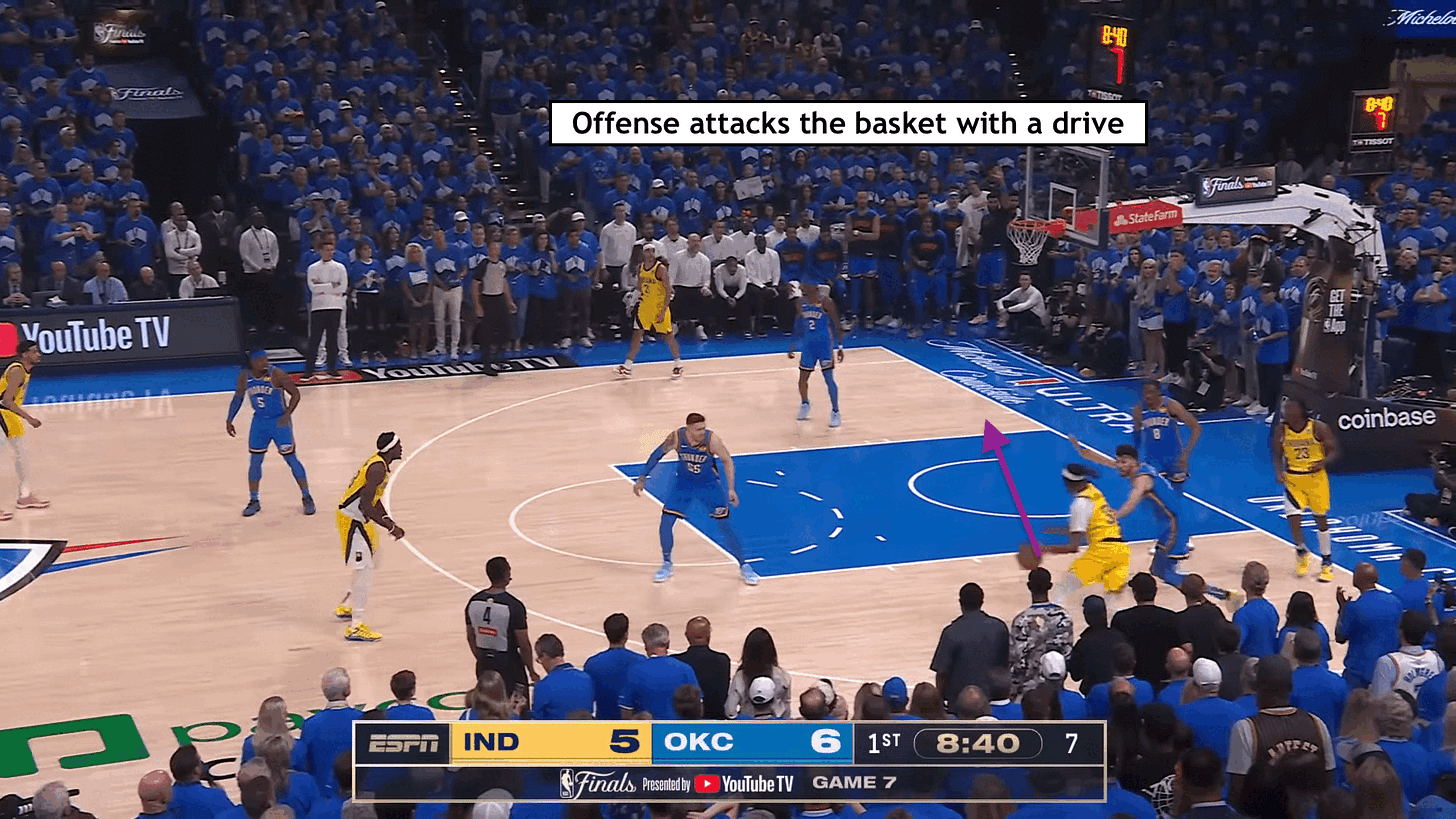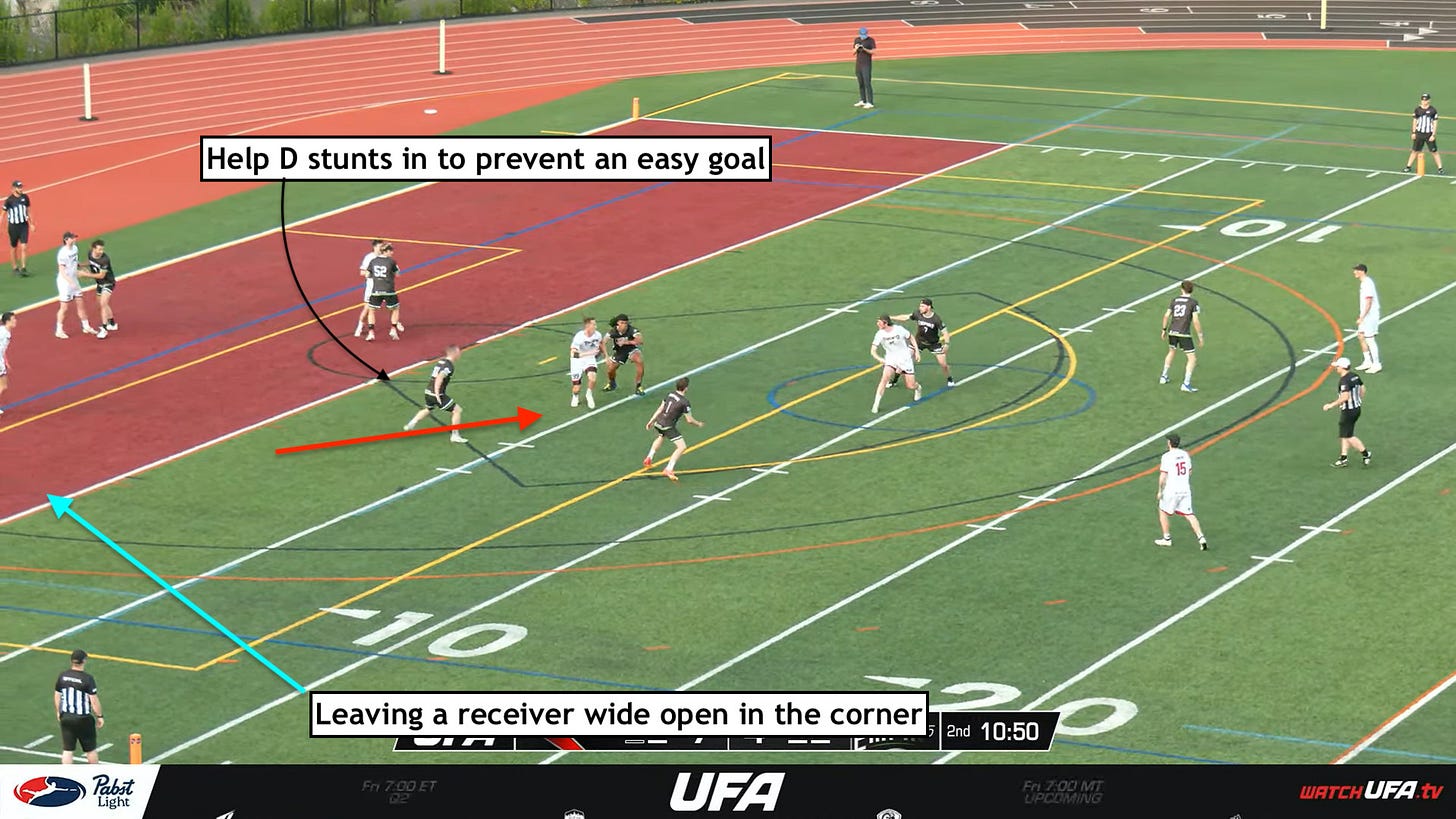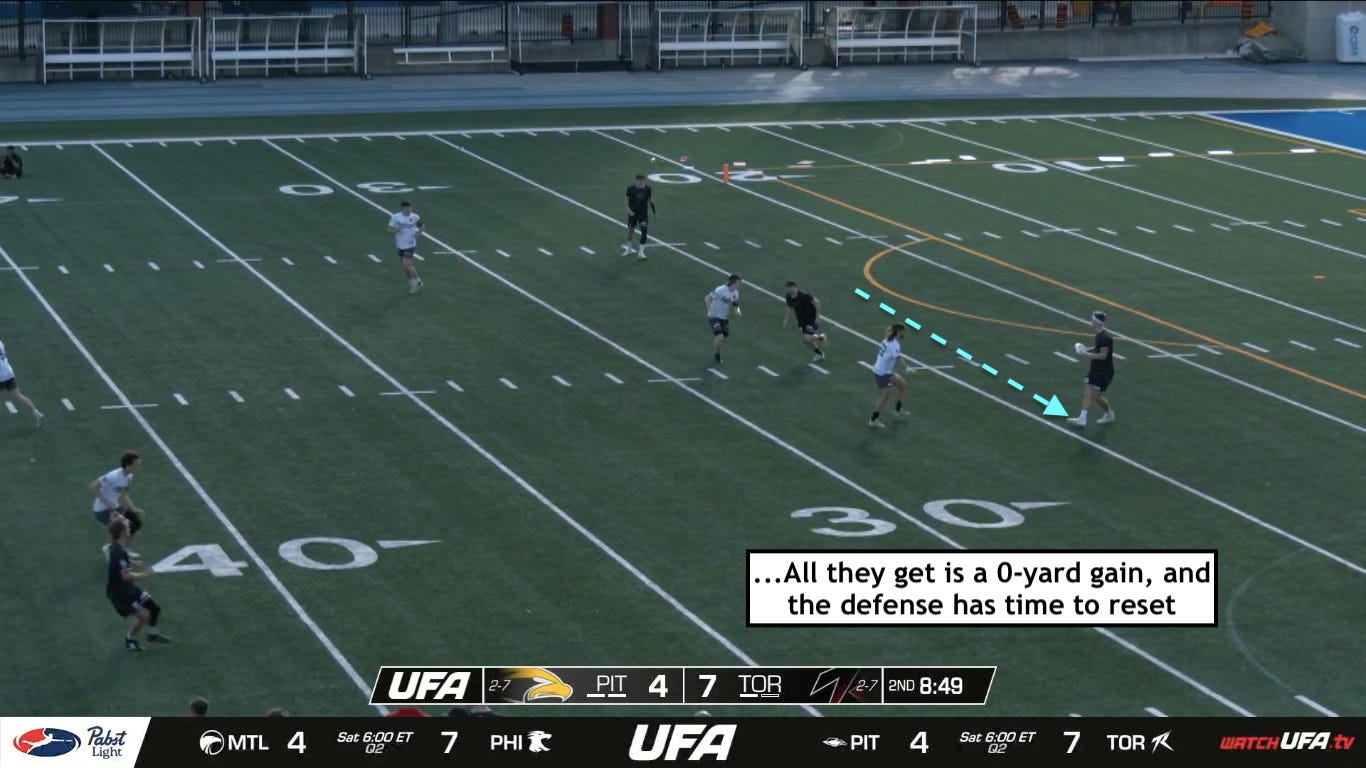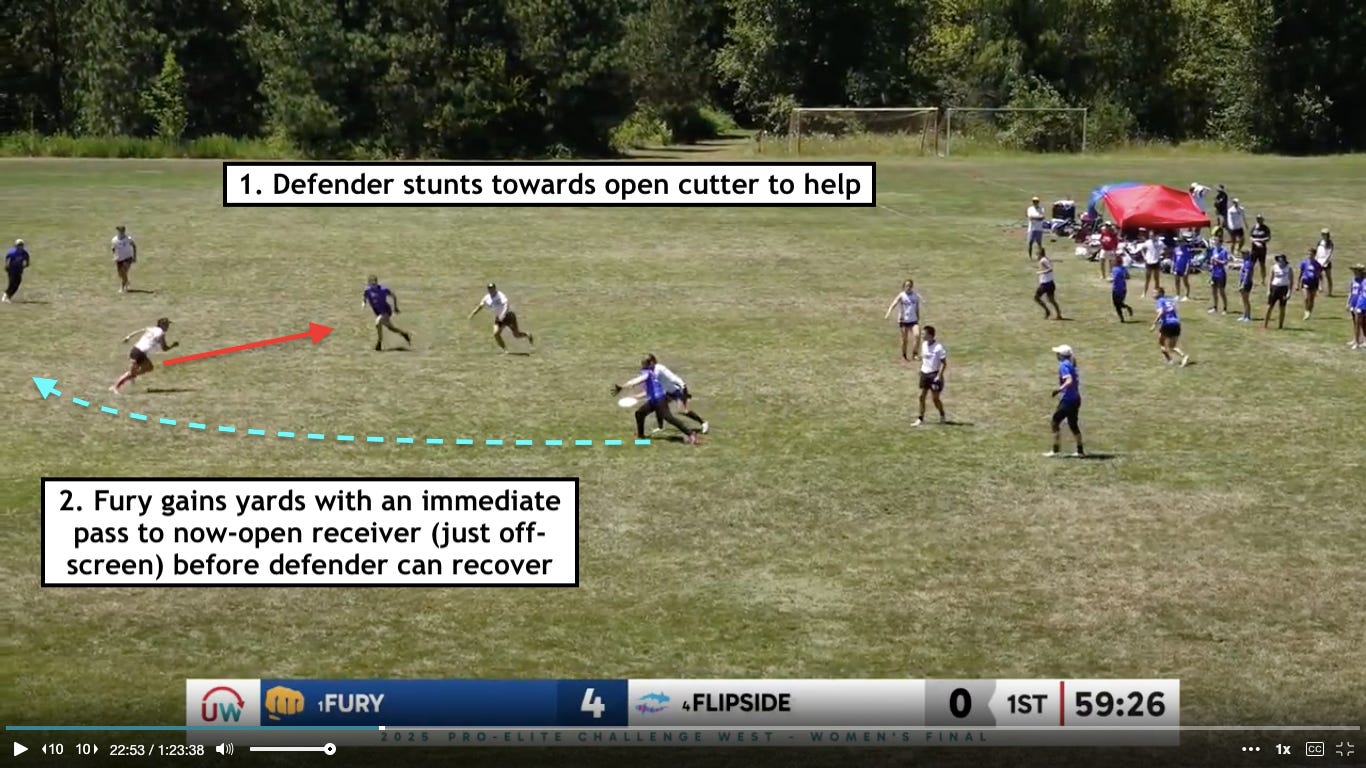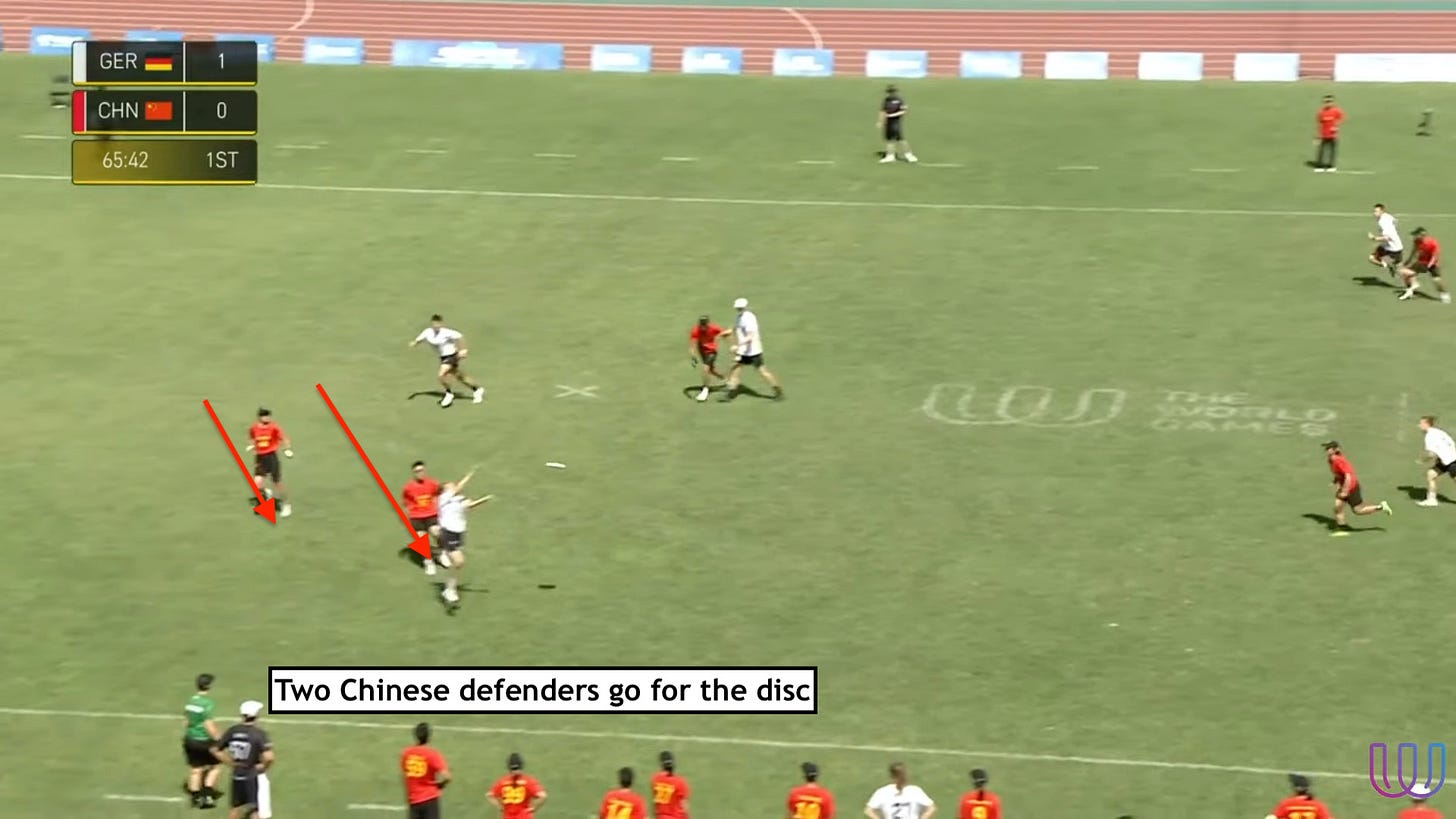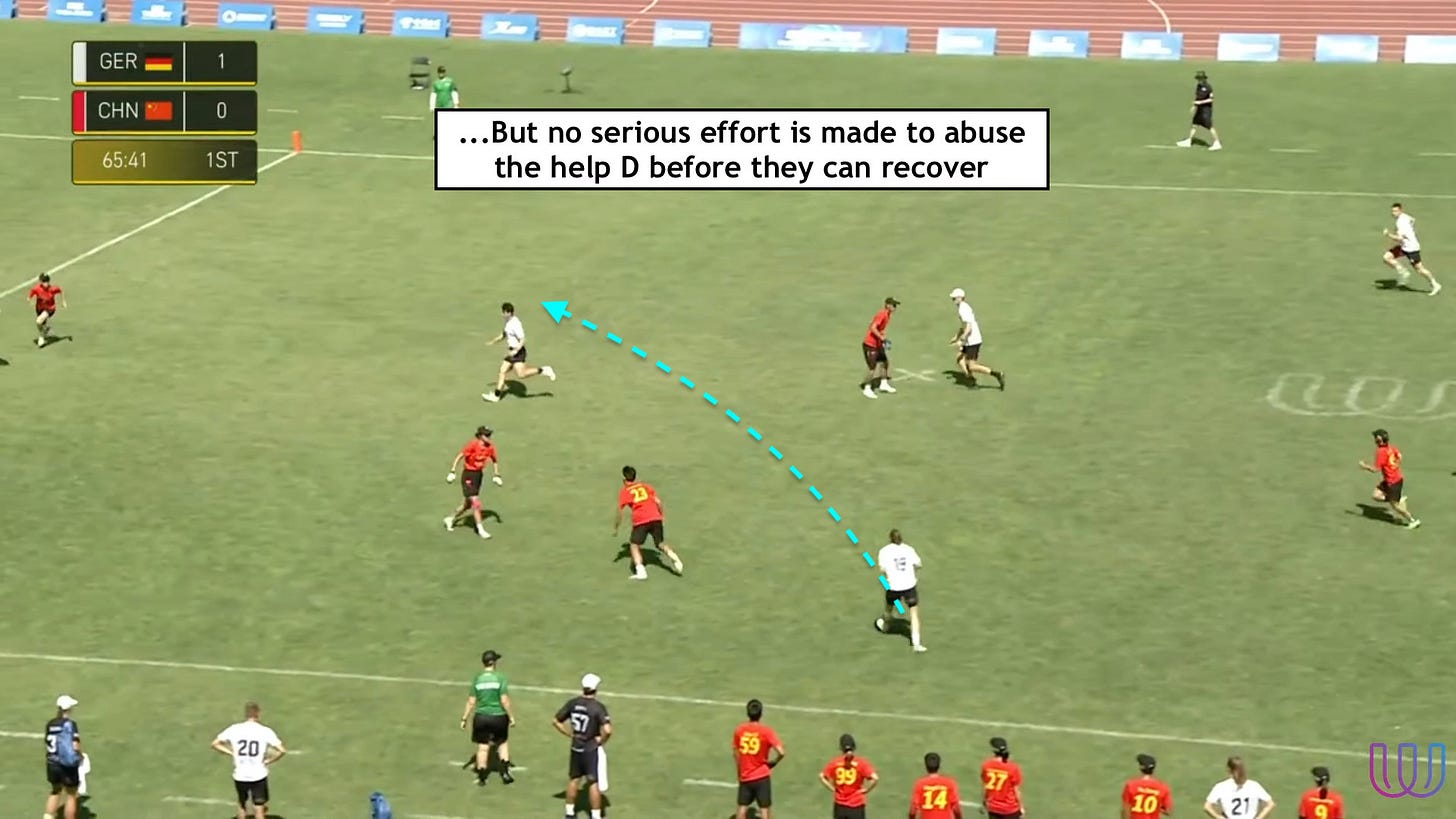The art of beating the help defense back to the second option
Can you punish a defense that puts 'two on the cut'?
I don't know how to start this article because it feels super important but simultaneously too obvious to be worth going into this much detail. Hence the awkward title.
Here's the basic thesis: more frisbee players need to understand that punishing poaches—getting the disc to an open teammate, before the defense can recover—is one of the core concepts of good offense.1
Let's talk, for a moment, about how offense and defense work in basketball. Offenses aim to generate an advantage using actions like a drive or a pick-and-roll. When a player has a 1-on-1 advantage, the defense will rationally respond by sending help—a second defender —to slow the offense at the point of attack.
But help defense at the point of attack is an advantage for the offense. The Warriors wantteams to double-team Steph Curry after a pick-and-roll—it means they're playing 4-on-3 once Steph makes the right pass. The Nuggets want teams to double-team Nikola Jokic in the post—they know he'll find the open man.
Help defense is an advantage, but the thing is, the advantage is somewhere else. The player with the ball needs to read the defense and get the ball somewhere else. And if the offense wants to win these momentary battles, they need to do it before the defense can recover.
I honestly don't know that there's a name for this in basketball exactly... read-and-reacting? It's kind of just...how modern basketball works. Watching a recap video of the most recent NBA game (NBA Finals Game 7), two of the first three Pacers baskets—at 3:30 and at 3:40—are obvious examples of this style of 'forcing help and passing out of it' (their first score was more of an isolation play).
I've broken down the second of those plays into a GIF below, highlighting how the offense forces the defense to help, then keeps the ball moving to punish the help and finally get an open shot:
Boston Celtics coach Joe Mazzulla has famously and hilariously (paywalled, maybe) referred to this as "putting two on the ball"—i.e. forcing two defensive players to guard the ball.
On the defensive side, this style is often called "help and recover"2. It's the "recover" that's of interest to us here: the offense has to play fast enough that they can outpace the defense's attempts to recover.
Since double teams aren't legal in frisbee (besides in the UFA), "putting two on the ball" doesn't translate literally. But the obvious parallel is what you might call "putting two on the cut"—cutter A gets open, and forces defensive help, which opens up cutter B.
Although I kind of hate the word "poach" for the connotations it carries, I favor a poachy style of defense. I think smart positional play is the optimal way to make things hard for the offense. But the offense has responses to this style.
Good defenders have implemented this step forward in the frisbee "meta". But from what I've seen, many offensive players still haven't countered that adaptation—they haven't built the skills to maximally punish help-and-recover frisbee defense, before it can recover.
This play below from the Toronto Rush vs New York Empire Free Friday Frisbee game is just about a textbook example of the concept.
The Rush get the disc at the center of the goal line after an Empire foul. On offense, Arvids Karklins is isolated at the front of the endzone, and as the disc comes into play he cuts away from defender Antoine Davis.
The Empire's Tristan Yarter (#33)3 sees the cut developing, and makes the smart decision to play help defense instead of allowing an open goal on a simple backhand.
When Yarter decides to "put two on the cut", the Rush receiver he's guarding is now wide open in the corner of the endzone.
The Rush thrower doesn't find the open man—when the easy pass to the first option isn't available, he looks to dump the disc backwards instead of looking to punish the help defense.
The defense helped and recovered, and, with a receiver wide open in the endzone, the offense failed to read-and-react.
Of course...the Rush scored literally one pass later. But, as always, I'm analyzing this from a process-oriented perspective, not a results-oriented perspective. The Rush turned the disc over 211 times in 2025, so while this particular play didn't punish their suboptimal play, there's certainly an opportunity to optimize their offense.
Frisbee players in general seem to have a mindset of if we just play safely and patiently, no defense can force turnovers on us. But (as I've mentioned many times before), that's clearly not true—the are multi-turnover points at the World Games, even the good offense lines in the UFA score on only 60-70% of their possessions, etc. There's efficiency gains to be made in seizing the good opportunities the defense gives you.
The following play by Team Canada at the 2025 World Games shows you what to do in a very similar situation. Again the wing defender stunts inwards, but this time the thrower puts an immediate backhand to the receiver on the sideline.
The pass is maybe a little close for comfort, but it just beats the defender back and results in a score.
Handler defenders sagging into the lane is an extremely common occurrence nowadays. This clip, from another 2025 Toronto Rush game4 exemplifies exactly what I think you shouldn't do (Thunderbirds at Rush (paywalled) at 47:15):
Even though there's a *huge* poach from the side handler's defender, and lots of open space, all the Rush get out of it is a swing for no gain, and the defense is given time to completely reset back to their assignments before the disc moves again.
Here's a counterexample from a 2025 San Francisco Fury game where Fury gets it right (Fury vs Flipside (paywalled) at 22:50). The Flipside handler defender stunts towards an open cutter coming into the lane, so the thrower holsters the original pass and immediately adjusts to throw a yardage-gaining pass to the now-open receiver.
Not too surprising that this would be yet another thing Fury does well. If anything, it's a quicker, less obvious poach than the Rush faced but Fury gets more out of it.
Here are two final examples from the World Games that caught my eye.
This first play (CAN vs FRA at 24:28) is another example of what I would say is suboptimal offensive play. Thomas Edmonds, playing D for Canada, sags into the lane. Although the play seems like nothing special, to me this is a big win for the defense. They get pretty much everything they could want out of it:
Edmonds prevents a pass from going downfield
AND they eventually throw a dump losing nearly 10 yards
AND they don't change the angle of attack / get any further away from the sideline
AND Edmonds recovers in time to prevent any break throws.
Gael Ancelin, the French handler, does put his hands up to call for the disc back. Getting the disc back quickly can be a smart play, as it gives him a second or two for an unmarked throw and a chance to give-and-go and keep the separation from a recovering Edmonds.
It's unconventional, but I would've actually preferred for him to attack the upfield open space himself. There's SO MUCH open space that any sort of over-the-top throw is wide-open, and he'd be gaining yards and catching with forward momentum instead of losing yards. (I'm not surprised he didn't do this, though, because I doubt the thrower would've been comfortable throwing that throw immediately. But the point is I'd like to see them get there, and I'd like to see people understand that this is an important skill to develop.)
A final example from Germany vs. China (GER vs CHN at 14:40). As Germany swings the disc, a Chinese player makes an ill-timed attempt to get a block, leaving their assignment wide open in the middle of the field.
There's endless space to put a pass into, but the German thrower really doesn't seem interested in abusing the help defense. (Yes, a scoring throw eventually goes up to the same open player, but it's clearly because the defender recovered but chose to play too far under, NOT because the defender never recovered.)
As this clip and the Canada v. France clip above highlight, playing fast gives you more leeway to throw imperfect passes. The receiver is so open that as long as the pass is released quickly and is generally thrown to the open space, there's no one else nearby with any chance to make a play on it.
Final thoughts
To sum it up:
Defenders are going to poach/play help defense. That shouldn't surprise you at this point.
Help defense should be thought of as an opportunity for the offense to exploit an advantage somewhere else.
Good defenders are going to make it hard on the offense to abuse help defense by recovering as quickly as possible.
Great offensive players need to look to abuse help defense before it can recover.
Too many players aren't doing this well yet. Every unpunished sag/help/poach is a win for the defense—letting one defender successfully guard more than one offensive player.
Seizing these opportunities means building the mental and physical skills (quick grip change, quick release, accuracy on quickly released throws, etc) to play fast—once again, it's point five frisbee.
Learn to change your mind faster than the defense can respond.
On a team level, a modern offensive "system" needs to know help defense will happen and prioritize strategies to neutralize it.
Throwing accuracy is less important when abusing help defense, because players are—momentarily—wide open. Quickly put throws to wide open spaces.
As a thrower, reading the poaches is just as important a skill as reading the one-on-one matchups.
I've mostly written this article from a thrower's perspective, but obviously the helped-off-of receiver has a role to play here, too, in (quickly and aggressively) finding the space where the thrower can get them the disc and calling for the pass.
Do we have a name for this concept already? If not, what should we call it?
See what I wrote in this article: "good throwers and good cutters have a healthy obsession with immediately taking advantage of defenders who dare to play too much help defense." This post is the full-length version of that comment, I suppose.
AKA "stunt and recover"; closely related is "helping the helper" if it's someone other than your original assignment you're "recovering" to
I'm pretty certain that's him, but he seems to be wearing a different number than usual
... I watched a lot of film for this article...
